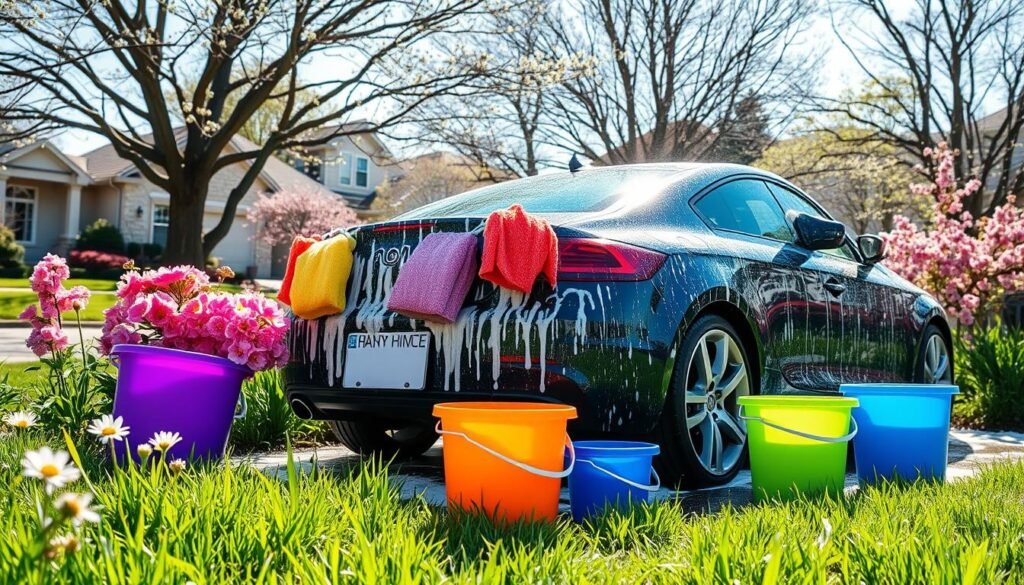Keeping your car in top shape is key for its performance, safety, and life span. This guide offers UK drivers vital car maintenance tips for all seasons. It covers how weather affects your car and the specific care needed for each season.

Key Takeaways
- Discover the importance of year-round vehicle care and its impact on performance and cost savings
- Learn about the effects of weather on your car and how to mitigate them through seasonal maintenance
- Explore the safety considerations that should be addressed throughout the year
- Understand the essential maintenance tasks required for each season, from winter prep to summer heat protection
- Familiarize yourself with fluid checks, tire care, and the differences between professional and DIY maintenance
Understanding the Importance of Year-Round Vehicle Care
Keeping your car in good shape is key to being a responsible car owner. It’s vital to follow a vehicle maintenance schedule all year. Weather affects your car’s performance, regular maintenance saves money, and safety needs change with the seasons. This makes a detailed car maintenance checklist essential.
The Impact of Weather on Vehicle Performance
Weather extremes can harm your car. In winter, snow, ice, and cold can weaken the battery and make tires slippery. They also cause rust and corrosion. Summer heat stresses the engine and coolant system.
Cost Benefits of Regular Maintenance
Regular maintenance, like oil changes and tire rotations, may seem expensive. But it saves money in the long run. Catching small problems early prevents big, costly repairs. It also keeps your car running well, saving fuel and possibly extending its life.
Safety Considerations Throughout the Year
- Proper tire tread depth and inflation for different seasons
- Functioning lights, wipers, and other safety systems
- Brakes and suspension in good working order
- Regularly checking for recalls or safety-related service bulletins
By following your car maintenance checklist and a consistent vehicle maintenance schedule, you protect your investment. You also improve performance and ensure safety for you and your passengers all year.
Winter Car Maintenance Essentials
As winter gets closer, make sure your car is ready for the cold and tough driving. Spending time on winter car prep boosts your car’s performance and safety. Here are key car maintenance tips for every season to keep your car running well in winter.
Winterizing Your Vehicle
Start by winterizing your car. Check and fill up fluids like antifreeze, windshield wiper fluid, and engine oil. Make sure the antifreeze is right to protect your engine from freezing.
Battery Care
Cold weather is hard on your car’s battery. Get it tested and replace it if needed before winter. A weak battery can leave you stuck on a cold morning. Also, think about a battery blanket or charger to keep it warm and charged.
Tire Maintenance
Good tire care is key for safe winter driving. Check your tires for enough tread and consider winter tires for better grip on snow and ice. Always check tire pressure, as it changes with temperature.
| Maintenance Task | Frequency |
|---|---|
| Check Antifreeze Concentration | Before Winter |
| Test Battery | Before Winter |
| Inspect Tires | Monthly |
| Check Tire Pressure | Monthly |
By tackling these winter car prep tasks, your car will be ready for the cold. Regular car maintenance tips for every season keep your car running well and last longer.

Spring Vehicle Care and Preparation
Winter is ending, and it’s time to focus on spring cleaning for cars. We need to get our vehicles ready for the warmer months. This is key to handle the damage from harsh winter weather.
Post-Winter Inspection Checklist
First, do a detailed post-winter check. Look for salt and rust damage, check your tires, and make sure all fluids are good.
- Inspect the undercarriage and wheel wells for salt and debris buildup
- Check the battery and electrical system for any issues
- Evaluate the condition of your windshield wipers and replace if necessary
- Ensure your tires have adequate tread depth and proper inflation
- Top up all essential fluids, such as oil, coolant, and windshield washer fluid
Addressing Salt and Rust Damage
Spring brings worries about salt and debris damage from winter. This can cause corrosion and rust, harming your car’s structure and performance.
To fight salt and rust, take these steps:
- Thoroughly wash the undercarriage and wheel wells to remove any accumulated salt and debris
- Apply a rust-inhibiting spray or sealant to vulnerable areas to prevent further damage
- Inspect the brakes, suspension components, and other critical systems for signs of rust or wear
Spring Cleaning Best Practices
After inspecting and protecting against rust, it’s time for spring cleaning for cars. This is a chance to make your car look new and get it ready for warmer weather.
| Spring Cleaning Task | Recommended Frequency |
|---|---|
| Exterior Wash and Wax | Every 2-3 months |
| Interior Detailing | Every 3-6 months |
| Tire Cleaning and Conditioning | Every 1-2 months |
| Window Cleaning | Every 1-2 weeks |
By following these spring cleaning for cars tips, your vehicle will look great and be ready for the new driving season.

Summer Heat Protection and Maintenance
When summer comes, your car needs extra care. This includes protecting it from heat damage and making sure the air conditioning works well. These summer vehicle maintenance tips will help your car run smoothly all summer.
Beating the Heat: Protecting Your Vehicle
The summer sun can harm your car’s outside and inside. To avoid heat problems, follow these steps:
- Park in the shade or use a sunshade to block direct sunlight.
- Regularly wash and wax your car to keep the paint protected.
- Check the coolant level and condition, and top up or flush the system if necessary.
- Look for cracks or wear in cooling system hoses and belts, and replace them if needed.
Keeping Your Cool: Air Conditioning Maintenance
A good air conditioning system is key to staying cool in summer. Here’s how to keep yours working well:
- Have a technician inspect and recharge the system.
- Clean the condenser coils to improve airflow and efficiency.
- Replace the cabin air filter to keep the air clean and fresh.
By following these car maintenance tips for every season, your vehicle will stay cool and in great shape all summer.

| Summer Maintenance Task | Importance |
|---|---|
| Coolant System Inspection | Ensures the engine is properly cooled to prevent overheating in high temperatures. |
| Air Conditioning System Maintenance | Keeps the cabin comfortable and improves fuel efficiency by reducing the load on the engine. |
| Exterior Cleaning and Waxing | Protects the paint from UV damage and heat-related issues, such as fading and cracking. |
Car Maintenance Tips for Every Season: A Comprehensive Checklist
Keeping your car in good shape is key to its long life and best performance. We’ve put together a detailed seasonal maintenance guide. It covers all the important tasks for each time of year.
Monthly Maintenance Tasks
There are some monthly tasks that are vital for your car’s health, no matter the season. These include:
- Checking and topping up fluid levels (engine oil, coolant, brake fluid, and windshield wiper fluid)
- Inspecting and replacing air filters as needed
- Rotating your tires to ensure even wear
- Cleaning the interior and exterior to prevent buildup of debris and grime
Seasonal Service Requirements
There are also specific tasks for each season to get your car ready for the weather changes:
- Spring: Get a full inspection to find and fix any winter damage, like rust or road salt harm.
- Summer: Make sure your cooling system works well and your tires are ready for the heat.
- Fall: Check your wiper blades and replace them if needed. Also, test your battery for the cold months.
- Winter: Put on winter tires, check antifreeze levels, and ensure your heating and deicing systems are ready.
Emergency Preparedness Tips
It’s also crucial to be ready for emergencies on the road. Always have these items in your car:
- A well-stocked emergency kit with tools, jumper cables, a flashlight, and first aid supplies
- A set of winter safety gear, such as ice scrapers, sand or cat litter for traction, and warm clothing
- A list of emergency contact numbers and a charged mobile device to call for assistance if needed
By sticking to a detailed vehicle maintenance schedule and car maintenance checklist, you can keep your car running smoothly and safely all year round, regardless of the season.

Essential Fluid Checks and Replacements
Keeping the right fluid levels and replacing them on time is key for seasonal car care and vehicle maintenance schedule. Engine oil and coolant are crucial for your car’s smooth operation all year round.
Regular oil changes protect your engine from damage. Change your oil every 5,000 to 7,500 miles, or as your car’s manual says. Make sure to use the oil type your car needs, as shown in the owner’s manual.
Coolant, or antifreeze, is also vital. It keeps your engine at the right temperature, preventing overheating in summer and freezing in winter. Check coolant levels seasonally and flush and refill it every 30,000 miles, as recommended.
Brake fluid is often forgotten but is just as important. It can get dirty over time, making your brakes less effective. Check brake fluid levels every six months and replace it every 2-3 years, or as your car’s manual advises.
| Fluid | Recommended Replacement Interval |
|---|---|
| Engine Oil | Every 5,000-7,500 miles |
| Coolant | Every 30,000 miles |
| Brake Fluid | Every 2-3 years |
By keeping up with these fluid checks and replacements, you ensure your car runs well and safely, all year.
Tire Care and Maintenance Through the Seasons
Keeping your tires in top shape is key for your vehicle’s health and performance, all year round. Adjusting tire pressure, rotating, and aligning your wheels are crucial. These steps can greatly improve your car’s fuel efficiency, handling, and safety.
Seasonal Tire Pressure Guidelines
Tire pressure changes with temperature. It’s vital to check and adjust it regularly. In cold months, check tire pressure monthly to avoid underinflation. In warmer seasons, inflate to the recommended PSI for best performance and fuel economy.
Rotation and Alignment Schedule
Regular tire rotation and wheel alignment are essential all year. Rotate tires every 5,000 to 8,000 miles for even wear. Have your wheels aligned yearly, or sooner if you notice uneven wear or steering issues.
When to Switch to Seasonal Tires
Drivers in areas with clear seasons should consider winter and summer tires. Winter tires improve traction and control in snow and ice. Switch to summer tires in warmer months for better handling, braking, and fuel efficiency.
By focusing on seasonal car care and car maintenance tips for every season, your vehicle will be ready for any weather and road conditions all year.
Professional vs DIY Maintenance: What You Need to Know
When it comes to keeping your car in top shape, you have two choices. You can take it to a professional mechanic or try to do it yourself. Each method has its own benefits and things to consider. Knowing the differences can help you decide what’s best for your car.
The Benefits of Professional Maintenance
Professional mechanics have the skills, tools, and equipment for many tasks. They can do a detailed check, find problems, and fix them accurately. Plus, many shops offer warranties, which means you’re covered.
The Advantages of DIY Maintenance
Doing it yourself can save money and teach you about your car. Simple jobs like oil changes and tire rotations can be done at home. This way, you can take care of your car and maybe even make it last longer.
| Professional Maintenance | DIY Maintenance |
|---|---|
| Expertise and specialized tools | Cost savings |
| Comprehensive inspections and diagnostics | Hands-on learning and understanding |
| Warranty on work performed | Ability to perform simple tasks |
Choosing between a pro and DIY depends on your skills, the task’s complexity, and how comfortable you are with car work. For simple tasks and minor fixes, DIY is fine. But for complex or safety-critical issues, a pro is safer.
“Proper vehicle maintenance is essential for ensuring your car runs smoothly and safely throughout the year.”
By knowing the good and bad of each method, you can create a maintenance plan that fits your needs and budget.
Fall Car Service
As the weather gets cooler and leaves fall, it’s time to get your car ready for autumn. A fall car service is key to making sure your car is ready for the season. It helps your car handle the cooler weather and any challenges that come with the changing seasons.
One important task in a fall car service is checking the heating system. A working heater and defroster keep you warm and safe. It also helps you see the road better. Plus, it’s important to check the antifreeze levels and flush the cooling system to avoid engine damage.
- Check the heating system for proper functionality
- Inspect and flush the cooling system
- Examine the tire tread depth and pressure
- Test the battery and replace if necessary
- Inspect wiper blades and replace if needed
Tires are also a big part of fall car service. Make sure the tread is deep enough and the tires are at the right pressure. This improves your car’s handling and saves fuel.
Finally, check the battery’s condition and replace it if needed. Cold weather can weaken the battery, causing starting problems. By doing these tasks, your car will be ready for the season and keep you safe.
| Fall Car Service Checklist | Frequency |
|---|---|
| Heating System Inspection | Annually |
| Cooling System Flush | Every 2 Years |
| Tire Tread Depth and Pressure Check | Monthly |
| Battery Test and Replacement | Every 2-3 Years |
| Wiper Blade Inspection and Replacement | Annually |
By keeping up with your fall car service and seasonal car care, your car will be ready for autumn’s weather and road conditions. Regular maintenance keeps your car running smoothly and safely all year.
Conclusion
In this article, we’ve covered key car maintenance tips for UK drivers all year round. We’ve talked about how weather affects your car and the importance of a maintenance checklist. Keeping your car in great shape requires ongoing care.
Following seasonal tips and checking fluids, tires, and getting professional services helps a lot. This ensures your car runs well, stays safe, and keeps its value. Regular car care is smart and keeps you and your family safe.
Whether it’s winter or summer, the tips in this article help you care for your car. By focusing on seasonal car care, you’ll keep your car running smoothly. Enjoy the confidence that comes with a well-kept, reliable car.
FAQ
What are the key benefits of year-round vehicle care?
Year-round vehicle care boosts performance and safety. It also saves money in the long run. A detailed maintenance schedule keeps cars ready for any weather and season.
How does weather impact vehicle performance?
Weather greatly affects a car’s performance and condition. Extreme temperatures and weather can harm the battery, tires, and engine. Seasonal maintenance is key to keeping cars safe and efficient all year.
What are the most important winter car maintenance tasks?
UK drivers should check the battery and electrical system in winter. They should also replace worn wiper blades and ensure tires are in good condition. Using winter-grade engine coolant is also important.
How should drivers prepare their cars for spring?
Drivers should inspect their cars after winter. Look for damage from salt and rust. Clean the undercarriage and check fluids and tires. Spring maintenance revives cars after winter.
What are the essential summer car maintenance tasks?
Summer maintenance includes checking belts and hoses. Drivers should also monitor fluid levels and ensure the air conditioning works. Protecting cars from heat and sun is crucial in summer.
How often should drivers perform routine maintenance checks?
Drivers should follow a car maintenance checklist regularly. Monthly checks and seasonal services are important. This ensures cars run safely and efficiently all year.
When should drivers switch to seasonal tires?
The best time to switch tires in the UK depends on the weather. Switch to winter tires when it’s below 7°C. Switch to summer tires when it’s above 10°C. Choosing the right tires is key for safety and performance.
What maintenance tasks can drivers perform themselves, and when should they seek professional help?
DIY drivers can handle simple tasks like oil changes and basic inspections. But, complex jobs like brake work or engine checks need a pro. Safety and reliability are important.
What are the key fall car maintenance priorities?
In fall, check the heating system and battery. Also, ensure tires have enough tread and pressure. Preparing for winter keeps cars safe and reliable.

